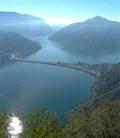Tombs, temples and statuary are all over a region that covers the bustling commercial city of Gyeongiu and the nearby mountains, fields, grottos and seashore.
The city and site are on Korea's southeastern coastline, a four-and-a-half-hour train ride or an hour-long flight from Korea's capital, Seoul. It's also accessible via frequent bus service from Busan, Korea's second-largest city.
Gyeongiu itself is a pleasant middle-class city (population approximately 580,000) that at first glance appears to be like many others. That is until you see the dozens of grass-covered minihills, assumed to be royal Silla dynasty tombs. A visit to the one that's been excavated and is open to the public is a genuine revelation, particularly as it demonstrates the kingdom's extraordinary wealth and power.
Located within Tumuli Park, very close to downtown with 23 tombs, the Cheonmachong (Flying Horse) tomb is an incredible experience. Opened in 1974, it was found to contain more than 10,000 items. On view now are replicas of a golden crown and girdle (the originals are in the Gyeongiu National Museum), weapons, jewelry and cooking utensils. Indeed, the tomb held just about anything a member of royalty might need in the afterlife.
Incidentally, this tomb, and presumably those yet to be explored, have survived remarkably vandal-free. One explanation is that the stones - before being covered with clay and soil - were stacked in a dome shape, with each level dependent for stability upon those above and below. Not unlike a house of cards, if any of the stones are disturbed, the whole structure could come crashing down on an unsuspecting interloper. While some bones of a possible robber have been found at a collapsed site, it appears likely that, in general, tomb looting does not appear to have been a major problem.
Of roughly similar vintage is Cheomseongdae, a 29-feet-tall, round structure, cleverly constructed from meticulously cut and symmetrically placed stones. Likely dating to the 7th century, many observers regard this as the Far East's oldest standing observatory.
Another must-see is the Seokguram Grotto, a UNESCO World Heritage site featuring a Buddha in a hillside stone enclosure that, a century ago, was accidentally discovered by a vacationing Japanese postal worker. Carved out of granite blocks at the top of Mount Tohamsan, it features an 11-feet-tall, seated Buddha flanked by some 40 smaller Buddha statues on the antechamber walls.
At the foot of the mountain lies another Silla masterpiece and UNESCO site, Bulguksa Temple. While its wooden structures are largely replacements, the millennia-old stone bridges, stairways and pagodas are original. Major surviving structures (experts say there were originally more than 80) include five temples, an assembly hall and a re-cast replica of an extraordinary bell, the original of which is now in the Gyeongiu Museum.
Another source of amazing artifacts was Anapji Pond, which once fronted a major Silla royal palace. The setting - featuring several mini-islands and surrounded by gardens and cherry trees (awesome when in bloom) - was drained in 1974. The resulting 700-item trove included an ancient boat, earthenware pottery and jewelry, most of which is now viewable at the museum.
Further afield near the Gampo seaside, there's the underwater tomb of Silla King Munmu. He wanted his ashes to be scattered on a seaside rock very near the shore. Convinced he could then be transformed into a dragon, the deceased king would still be able to defend his kingdom against invading Japanese.
Not far away is the Gameunsa Temple site erected by Munmu's son, King Shinmun, in A.D. 682. Remnants include a three-story stone pagoda and indications of a series of channels that once funneled seawater to the site.
While all of Gyeongiu is dubbed "a museum without walls," nowhere is this better illustrated than during a Mount Namsan sojourn. The downside, however, is that at peak seasons it can be almost as crowded as a city during rush hour.
Nevertheless, the higher you climb toward one of Namsan's 180 peaks (the tallest is the 1,620-feet-high Gowisanbong Pak), the clearer the field. For the most fit, the 30-by-16-feet Buddha relief, considered one of the most impressive Silla relics, is regarded as well worth the effort.
However, even for those lacking any desire to climb, there's a delightful ancient memorial near the mountain's base. Poseokjeong, once a banquet garden, features the granite waterway that was the site of royal drinking games. According to legend, the king would sit at one end and float boats laden with powerful drinks toward courtiers who lined the tiny canal. Wherever the boat stopped, the nearest participant had to down the drink and recite a poem.
As with so much of the Silla legacy, no books detailing drinking game practices - or virtually any other history or hard news about the Silla dynasty's extraordinary rule - have so far been fond.
Other prime draws in the museum's four buildings include pottery from the mundane to the exquisite, jewelry, a 14-sided die used to make choices in a drinking game, stone carvings, crowns, armor and cooking utensils.
There are also drinking glasses and beaded necklaces that, intriguingly, may have originated in Europe.
IF YOU GO
For more information about Gyeongiu or the rest of Korea, contact the Korea Tourism Organization at 800-868-7567 or visit tour2korea.com.
Korean Air offers nonstop flights to Korea from Chicago, Los Angeles, New York and San Francisco. Call 800-438-5000 or visit koreanair.com.
Robert Selwitz is a freelance travel writer.
© Copley News Service





